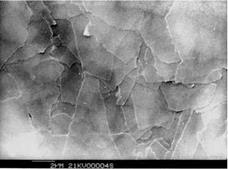Leafing/Non-Leafing
One of the most typical properties of metallic pigments is their wetting behavior in different solvents (including water) or binder solutions. Metal effect pigments are basically divided into leafing and non-leafing types (Figure 5.29).
Leafing pigments float on the surface ofthe wet film, orienting themselves parallel to the surface and thereby forming a dense metallic layer on top of the coating. This layer has a high reflectivity and provides excellent barrier protection of the film (resin).
This property is not only used for creating a high metallic “chrome effect” in decorative coatings and printing inks, but also for manifold applications in functional coatings like roof coatings, tank coatings, anticorrosion coatings etc.
|
Leafing |
^Non-leafing |
|
|
Pigment is floating |
Pigment is perfectly wetted |
|
|
«Chrome effect” |
«Metallic effect” |
|
Fig. 5.29 Wetting behavior of metal effect pigments: leafing and non-leafing. |
Non-leafing pigments on the other hand are perfectly wetted in the binder and therefore oriented more or less parallel to the substrate on the bottom of the wet film. The cured films are rub-resistant with an excellent adhesion to following clear coats. The pigmented film can easily be tinted with transparent color pigments or dyestuffs, thereby creating the typical polychromatic “metallic effect”.
Particle Shape

The shape of the pigment particle depends very much on the manufacturing conditions. Basically we distinguish between the traditional “cornflake-type” (irregular shaped) and the so-called “silver dollar-type” (lenticular, round-shaped, smooth surface). The thickness of these pigments varies from 0.1 to 1 pm (Figure 5.30).
 Fig. 5.30: SEM-photographs of aluminum pigments: a) Conventional “cornflake type”, b) Lenticular “sil — verdollar type”, c) VMP aluminum pigment.
Fig. 5.30: SEM-photographs of aluminum pigments: a) Conventional “cornflake type”, b) Lenticular “sil — verdollar type”, c) VMP aluminum pigment.
The VMPs (vacuum metallized pigments) differ very much from these traditional pigment flakes. Due to the original PVD-process, they are extremely thin (ca. 0.03 pm) and provide a very smooth, highly reflective surface. The particle shape has a tremendous influence on the metallic effect (see below).
The anisotropic shape of the metallic flakes should be considered during dispersion and application of these pigments: high shear forces may damage the pigments and the effect and should therefore be avoided.
 8 января, 2016
8 января, 2016  Pokraskin
Pokraskin  Опубликовано в рубрике
Опубликовано в рубрике 